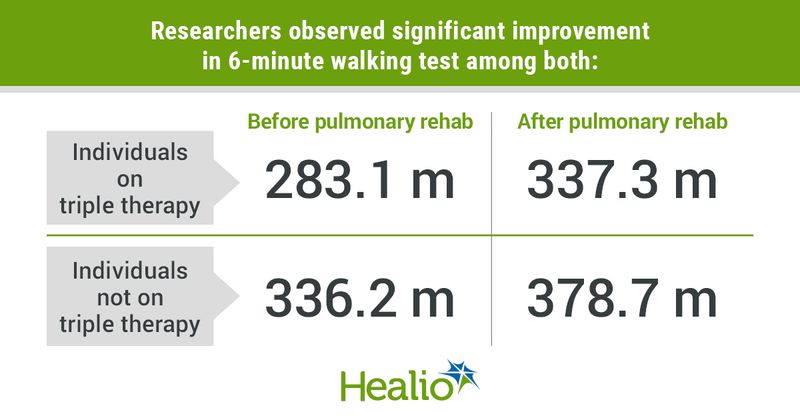Pulmonary rehab benefits patients with COPD regardless of triple therapy use
Pulmonary rehabilitation led to significant benefits among individuals with COPD regardless of inhaled triple therapy treatment, researchers reported in Respiratory Medicine.
However, the benefits of pulmonary rehabilitation were greater among triple therapy users, according to the results.

“To the best of our knowledge, this is the first large real-life study on the effectiveness of pulmonary rehabilitation in individuals with COPD using triple therapy as compared to those using no triple therapy,” Michele Vitacca, MD, from the department of respiratory rehabilitation at the Institute of Lumezzane at the Maugeri IRCCS Scientific Clinical Institutes in Brescia, Italy, and colleagues wrote. “This retrospective study on a large population shows that an in-hospital program results in significant benefits in exercise tolerance, dyspnea and disease impact in all participants irrespective of treatment. However, the size of improvement in exercise tolerance and dyspnea was higher in individuals using triple therapy.”
This multicentric, retrospective analysis included data from 1,139 individuals admitted to in-hospital pulmonary rehabilitation from July 2018 to December 2021. All individuals had a reported diagnosis of COPD. Researchers collected baseline characteristics, including demographics, anthropometrics, comorbidities, history of acute COPD exacerbation in the past 12 months, provenience from hospital or home, blood eosinophil count, length of rehabilitation hospital stay, presence of chronic respiratory failure, airflow distribution and Global Initiative for Chronic Obstructive Lung Disease (GOLD) stages. Use of inhaler therapy was recorded after reassessment.
The primary outcome was 6-minute walking test. Secondary outcomes included Medical Research Council scale for dyspnea and COPD assessment test.
Overall, 61% of participants were on triple therapy.
Researchers reported improvement in 6-minute walking test among those on triple therapy (283.1 m vs. 337.3 m; P < .001) and those not on triple therapy (336.2 m vs. 378.7 m; P < .001). There was a higher effect size (54.3 m vs. 42.5 m; P = .004) and proportion of individuals who reached the minimal clinically important difference of 6-minute walking test (64.2% vs. 54.3%; P = .001) among individuals receiving triple therapy, according to the researchers.
Both groups also experienced improvement in secondary outcomes. Significant independent predictors of reaching the minimal clinically important difference of 6-minute walking test included hospital provenience (OR = 2.177; 95% CI, 1.612-2.94), triple therapy use (OR = 1.332; 95% CI, 1.038-1.709) and high eosinophil count (OR = 1.665; 95% CI, 1.142-2.43).
“Whether these results are associated with the inhaled therapy used or with the characteristics leading to the use should be further evaluated with randomized controlled trials,” the researchers wrote. “Our data reflect the specific population of individuals with indications of pulmonary rehabilitation not comparable and extensible to other populations of individuals with COPD.”
